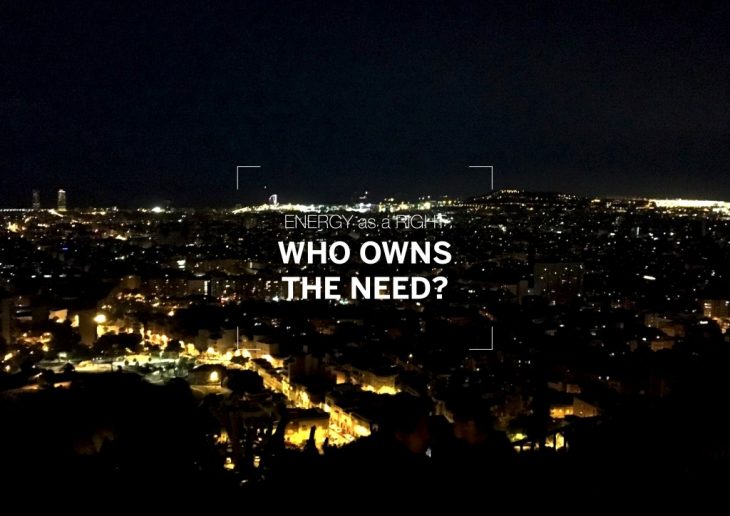
- Project of Iacopo Neri and Sylvain Totaro Iaac - MaCT 2016 Faculty: Tomas Diez, Mathilde Marengo -
Considering our daily life, the importance of Energy is more than obvious. This statement has been reinforced by the survey we proposed to the Poblenou’s retailers. Controlling Energies provide us the possibility to make our cities alive. It takes a crucial position in the lighting systems, as well as in transportation, telecomunication, heating/cooling, security, production, among many others. Being already a key point in nowadays society, the general trend of increasing people on earth together with the democratization of advanced technologies (even in developing countries), the awarness of the exhaustibility of natural resources, and the cities improvement based on advanced technologies, it makes the Energy topic more and more relevant for the design of our cities in a close future. Having that in mind, we started narrowing the notion of Energy to the notion of need, deepingly believing that it should be consider as a right.
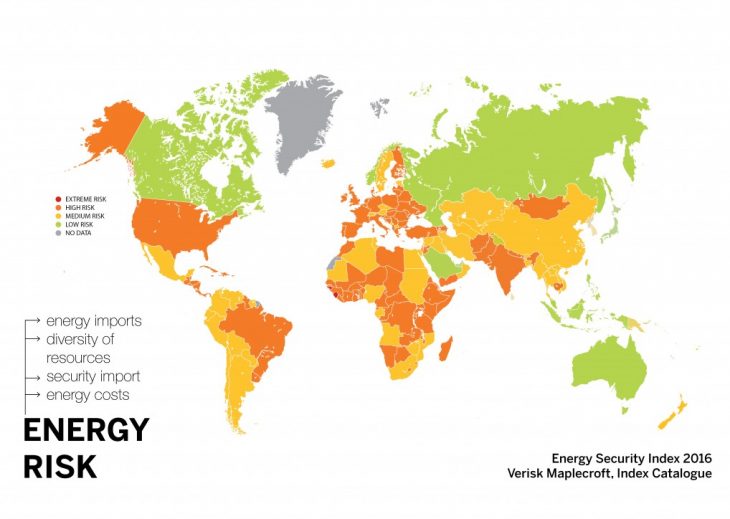
Taking in consideration the importance of Energy in our life, we understood the level of dependency behind Energy. In fact, Energy is a wide term which refers to several sub layers and it can be obtained from nuclear resources, as well as petroleum, gas, incineration, combined technics and renewable sources … However, according to the geolocalisation of each country, the access to resources together with the level of production is inequal. Following this idea, in the actual system, Energy relies on local productions as well as on productions from external countries. Consequently, the importance of imports, the range of diversity in the resources, the energy cost and the geopolitical situations between countries could give us an idea of the Energy risk per country. Surprisingly, we can notice on the map above that the level of Energy risk is quiet important for European countries.
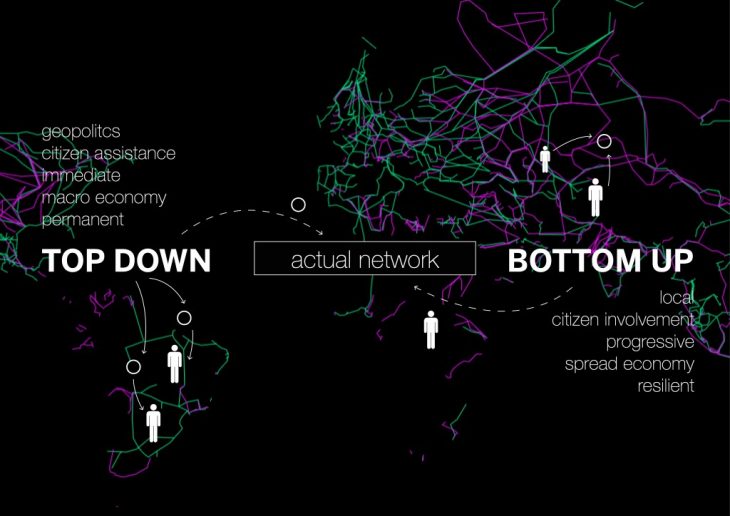
The fragility of the actual system is already matter of debate. We can notice that two main approaches are emerging from the discussions : the Top down and the Bottom up methods. While the top down provides an increase in the complementary interactions among countries in order to prevent an inequal repartition of resources, by taking advantage of the specific features in each country, the bottom up one acts for the development of a relevant local production with the aim of increasing the resiliency of cities and citizens concerning the Energy topic.
Even if the two proposals depend on opposite values and political analysis, they both offer interesting solutions to improve the actual Energy system. Nevertheless, by their own, they are still subject to criticism by showing some weaknesses. In fact, it is in the right combination of those two that we can create a powerful and stable system. This combinatory solution must take into account the diversity of resources at the global scale, while providing local alternatives in order to give to empower cities to maintain the right of access to Energy.
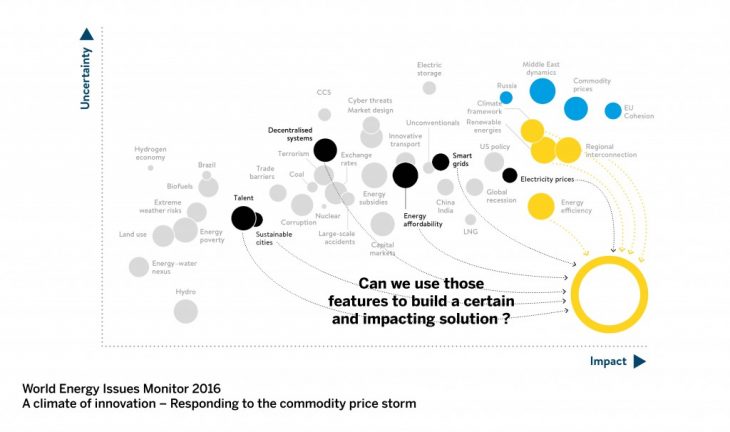
The Top down approach would focus on the development of a global Energy network, where the production of the whole planet is freely traded. A Bottom up approach, instead, would target other fields like “regional interconnection”,”energy efficiency”, “renewable energies” or “climate framework” which are shown in the upper diagram as impacting while being quiet uncertain solutions. At the same time, the values transmit by the Bottom up approach call notions like “talent”, “sustainable cities”, “decentralised systems”, “energy affordability”, “energy prices” or “smart grid” which could be added to the equation in order to build a concrete and impacting solution to improve our Energy network. Lastly, the World Energy Issues Monitor diagram shows that we cannot expect an impacting and certain solution, no matter which approach we trust: the only relevant solution will come up by merging several meaningful proposals.
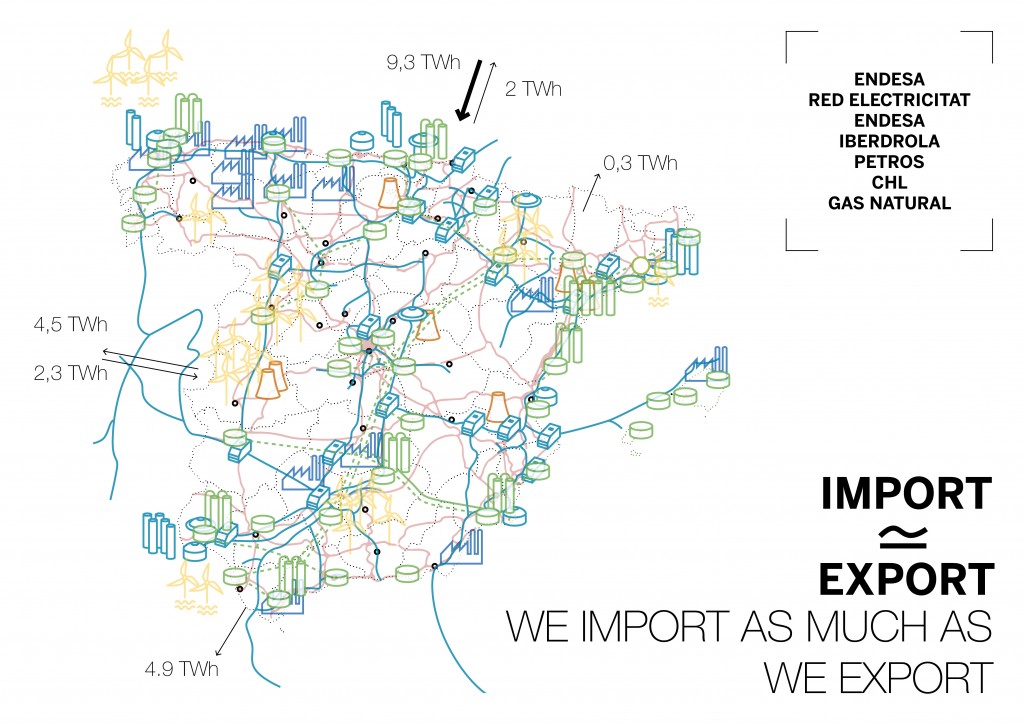
The spanish Energy network shown on the upper map reveals the complexity and the plurality of actors overlapping for different resources. From nuclear to solar, spanish reports record an amount of Energy import approximately equal to the amount of exports for the year 2015. Therefore, this map clearly states how Energy is a product within a global market. This observed reality twists from our personal belief about how the Energy should be consider. A system which deeply relies on plural private actors, either from Spain or abroad, creates a dangerous dependency that nothing has to deal with the actual need of the cities and consequently impoverish citizens, becoming feeble pawns in an uncontrolled game.
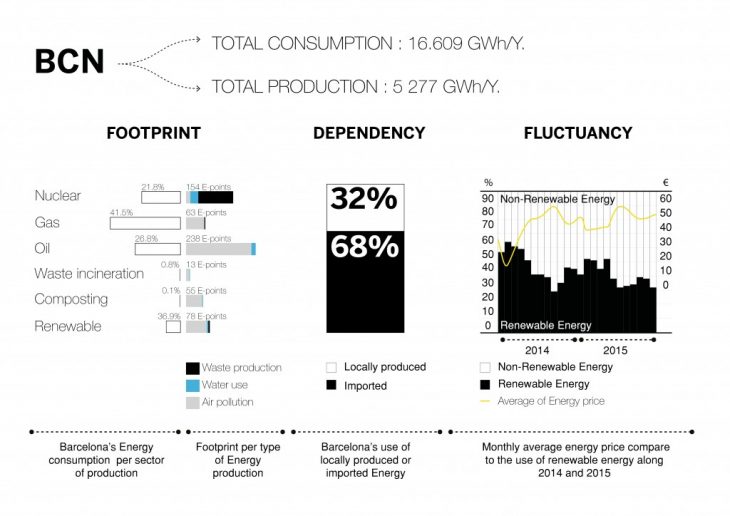
Considering the city of Barcelona as our case study, we reported, as we can see in the picture above, a general understanding of the local Energy network. The three most consumed type of Energy in Barcelona are also the one with the biggest footprint in terms of air pollution, water use and waste production. Only 32% of the consumed Energy comes from the region of Barcelona and Bessos. The price of the Energy is very unstable, as it tripled in the last two years. Moreover, the decrease of the Energy cost is linked to the increase of production of renewable Energies. We now take these observations as a base for our proposal.
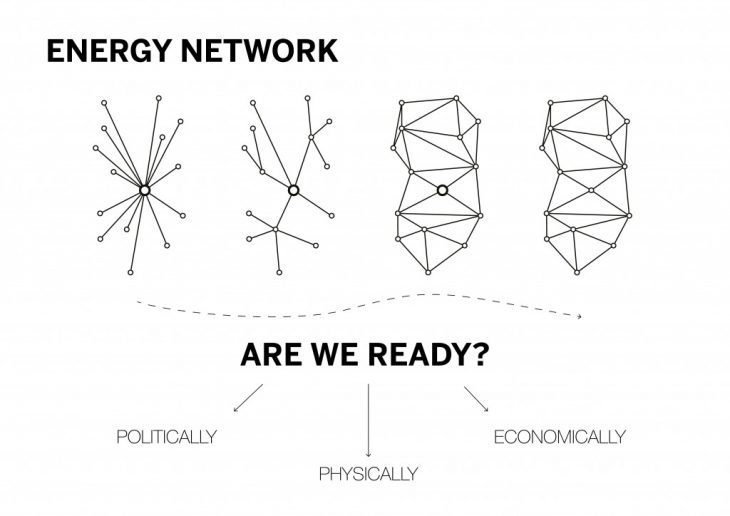
Another inspiring fact, for us, was the trend in the evolution of the Energy networks. If we remember the first power plants throughout our history, we suddenly moved, with the development of industrial technologies and needs, from a centralized system to a more spread and melt decentralized system in which the monopoly of big companies reaches infinite distances with the use of secondary substations. Nowadays, the most innovative solutions, to reshape and equally redistribute Energy, are pushing towards mesh-like networks. These type of approaches foresee systems in which the distinction between sources and consumers is null, empowering all the actors with the possibility to produce, share, donate and receive energy, completely unplugged from the flows of a bigger market and consequently independent, autonomous.
However, are we really ready for such a jump? Should we consider an intermediate step able to prepare the mesh infrastructure, without instantly rejecting our present system?
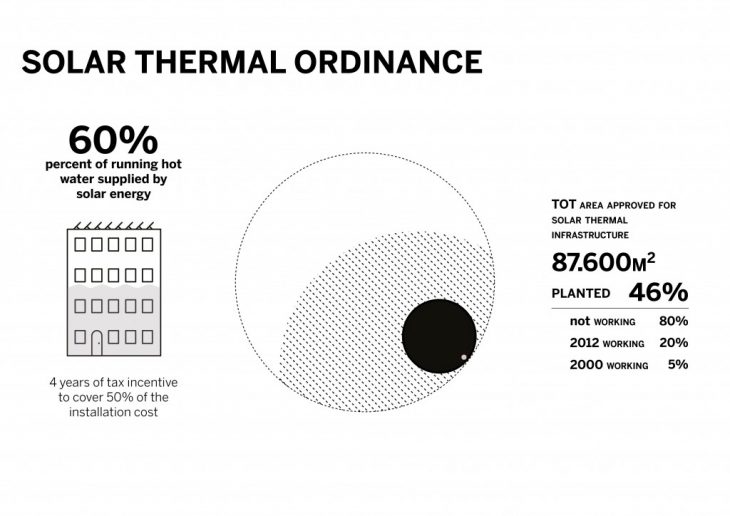
Under the political aspect, in 1999 the city council approved the solar thermal ordinance which required that new buildings, and those undergoing major refurbishment, meet at least 60% of their demand of running hot water with solar thermal collectors. After several year of implementation only 46% of the expected areas received solar installations, then only 20% are still working in 2010. This fact shows the unpredictability of the results of the self-sufficient policies as well as the political mistake of instant top down deployment of new infrastructure. Indeed, the implementation of advanced systems requires a total acceptation by the users as well as structured plans for management and maintanance. Following this observation, the jump towards a new mesh system in only one shot seems risky.
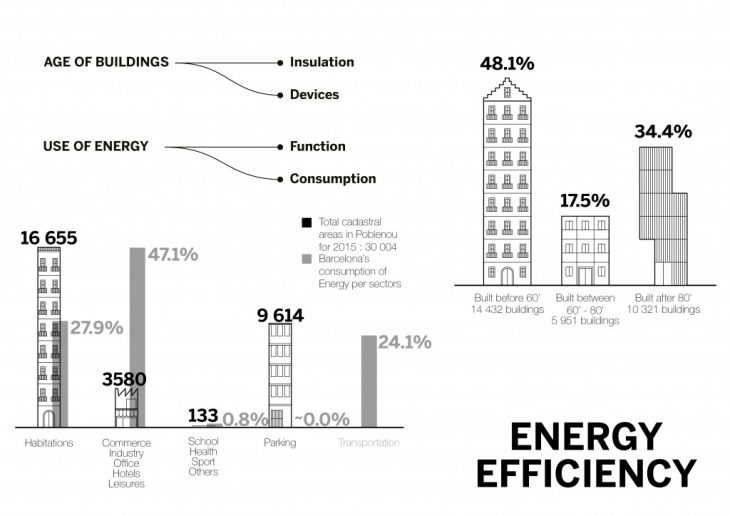
Being Poblenou our project’s site, it was necessary to understand the physical environment of the district in order to speculate which type of intervention could it support. As easy imaginable, the number of habitations is drastically higher than the number of activities, while the total of Energy consumption for the latter is almost the double than the amount of Energy consumed by the former. Secondly, almost half of the Poblenou’s buildings are older than forty years. This gives us a hint about the low level of insulation and devices that we can expect to find.
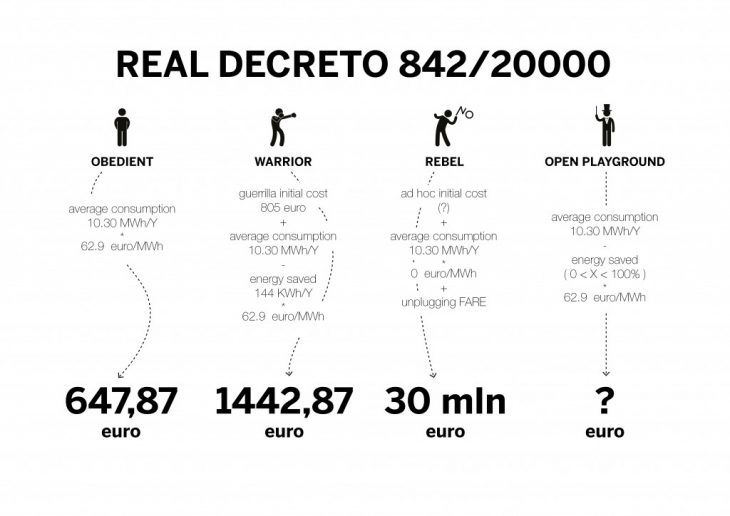
Facing the actual situation, the citizens of Barcelona can adopt different options and behaviors concerning the Energy issue. If the first one shows the traditional “obedient” behavior with relative prices, the second reports the Guerrilla Solar campain option (by the Fundacion Terra) which aims to provoke a change in the policies concerning Energy by providing “warriors” with guerrilla solar panels. Still, the solar panel has an initial cost of 805 euro and the possibiliy of saving only 40 euros a year does not represent an option that every citizen can afford. The third, or the “rebel”, represents the will of someone who stays off grid and has to pay a fare of 30 millions euros fixed by the real decreto 842/20000.
How can we imagine a fourth option? What alternative can we provide?
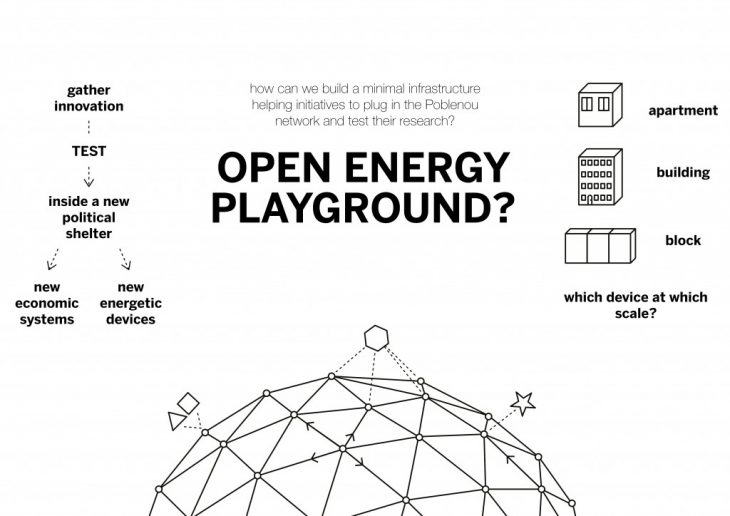
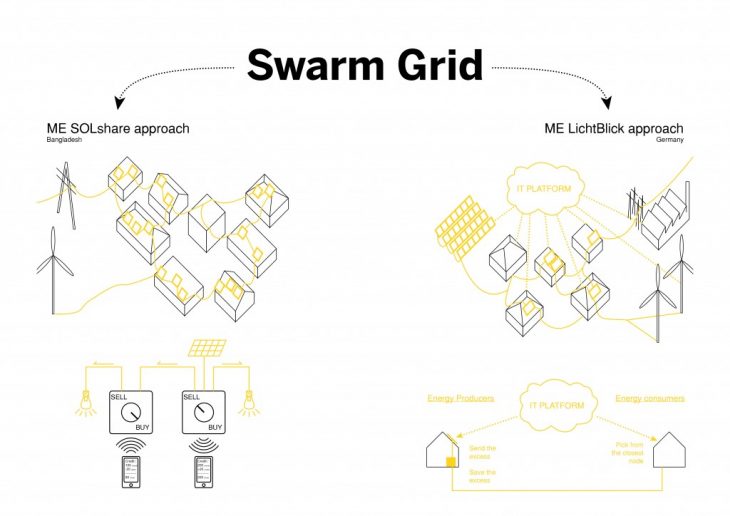
Relevant solutions are already present in several places around the globe. One of them is definately ME SOLshare. This solution respond to the difficult reality of Bangladesh in which the connection between every habitation and the grid is complex and hard due to economical and natural reason. In fact, frequent disasters damage the network continously making self generation devices for off grid situation a perfect solution to survive.
The system interconnect every habitative unit, productive with solar panels or not, in order to create a mesh network, giving the possibility to every dweller to sell or buy (in case of excess or need) the solar Energy produced. A simple box switches from Out to In and money are transfered via phone credit while energy is transfered from the closest points in the network.
Connecting one node, then an other and so on, the off grid network can get closer to the general network and finally plug the entire mesh to the grid.
The second reference is developed by the German company ME Litchblick. It uses a swarm algorithm to process data collected from the network in order to balance the energy according to the needs and the production. The goal is to interconnect each point of the network as a mesh and enable it to save a certain amount of Energy in its own location (even private houses), controlling the general flow of Energy ith short connections. By spreading the Energy on the whole network, the company can manage the peaks of Energy needs more efficiently, avoiding the overload of systems created by a centralized monopole of management.
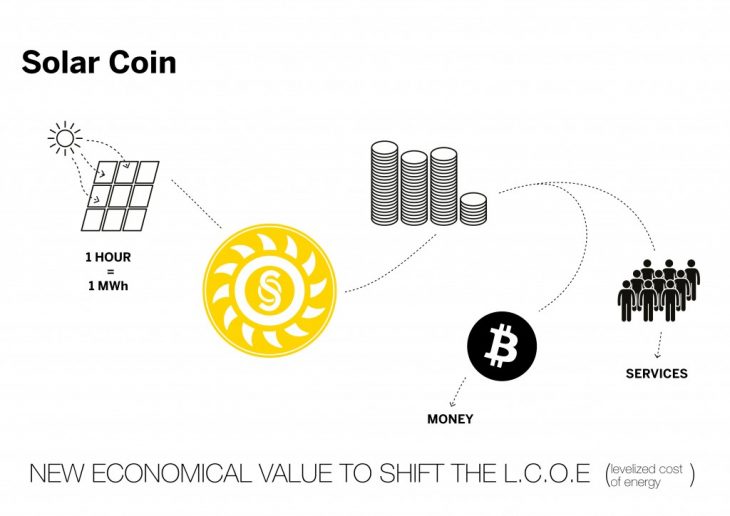
The solar coin project gives us an interesting approach to new economic systems related to the Energy topic.
By creating a new value linked to the solar production, the proposal aims to shift the levelized cost of energy towards a more decent market. One solar coin is gained with one hour of solar panel’s activity and it can be translated into bitcoins or traded for services, by the users of the community,
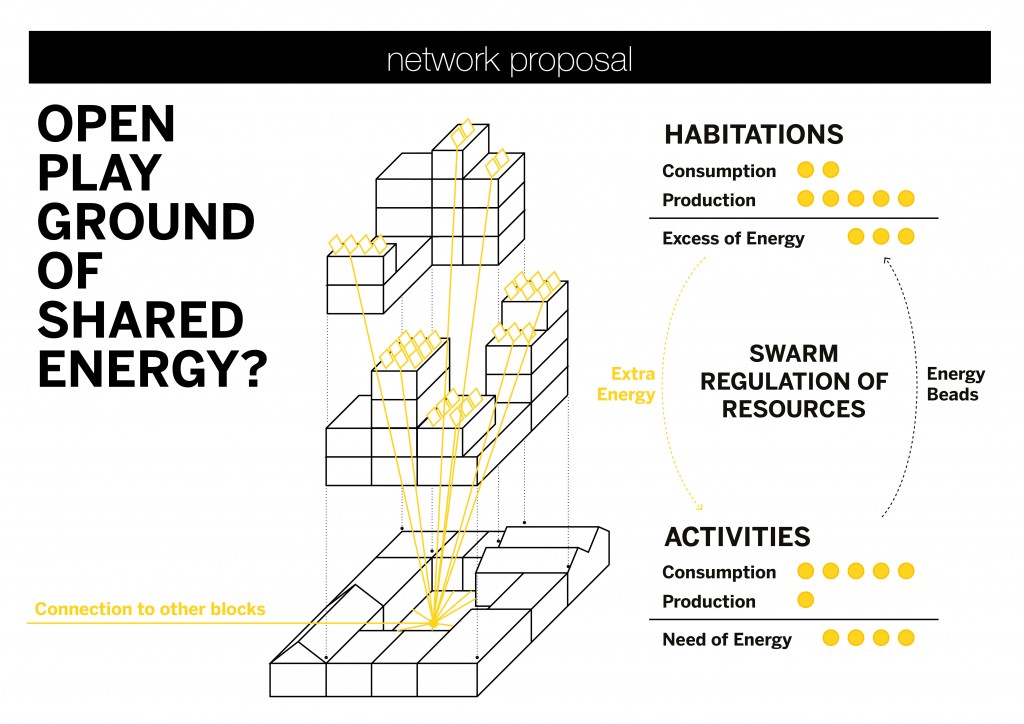
So why not proposing a solution that can be added to the actual Energy network as an alternative? A complementary mesh at the scale of the Poblenou district which can be used as an open playground to freely plug and test new toys or innovations in the Energy field. A testbed for creative ideas with a softer regulation supporting new solutions regarding the Energy issues.
In the present constrained urban fabric of Poblenou, each block could represent a node of the mesh. Energy could be saved at the block scale or joined to the rest of the network to balance the need in other nodes of the mesh. Empowered by productive devices, dwellers could create solar currency, called Energy beads, to trade various services with the activities below, enhancing local interaction and cooperative aid.
Energy as a right, WHO OWNS THE NEED? is a project of IaaC, Institute for Advanced Architecture of Catalonia developed at Master in City and Technology, in 2016 by:
Student: Iacopo Neri, Sylvain Totato
Faculty: Tomas Diez, Mathilde Marengo
